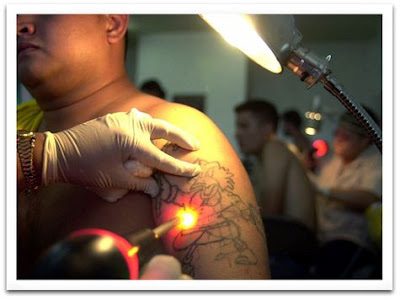 |
| Laser Tattoo Removal |
If you are considering the possibility laser tattoo removal, you're not alone. Statistics indicate that more than 50% of all individuals who have some type of body art decide that th
Unfortunately, most people experience some pain when having this procedure done. Doctors typically recommend taking a product such as Tylenol, which will help with minor discomfort, right before your appointment.
Another pre-treatment option is prescription anesthetic cream that is applied approximately two hours before surgery and wiped off right before the procedure begins.
Lasers work quite well to get rid of body art. Short pulses of light go through the top layers of skin and are absorbed by any pigment they come in contact with. The pigment then breaks up into very small particles, which are eradicated by way of the immune system.
Protective eyewear is required while you're receiving laser treatment. When more than one session is necessary, you should notice the ink getting lighter with each visit. Of course, everyone has a different threshold when it comes to pain. But most people will tell you that each laser pulse feels similar to a large rubber band being snapped on your skin.
It's possible that you might experience a bit of surface bleeding that sometimes occurs during tattoo removal. This doesn't last long and is nothing to be overly concerned with.
Once the process is complete and your body art is gone, that area might feel sunburned for a few days. Antibacterial ointment will help to relieve discomfort and eliminate the possibility of any infection.
Some type of gauze bandage is usually recommended for a few days, just to keep the area protected. It should be changed on a regular basis. It is also possible that a scab will form. If it does, it should be allowed to heal naturally.
Some people are initially concerned that the laser pulses will also damage non-pigmented skin cells. However, that is not the case. The only thing that is affected is the ink itself.
It should be noted that some cosmetic surgeons will tell you that it's impossible to totally eradicate ink from your skin. Successful tattoo removal depends on several things. New ink art is harder to get rid of that older art. It also depends on the size and location of the picture or pictures and the experience level of the artist who performed the work.
Black ink is easiest to disintegrate, because it absorbs all wavelengths of a laser. Other colors such as green are more difficult, since they can only be erased with certain lasers for tattoo removal. You just have to remember that this ink is meant to be permanent. So, it typically takes time to remove.
ey no longer want it, at some point in their lives.
Unfortunately, most people experience some pain when having this procedure done. Doctors typically recommend taking a product such as Tylenol, which will help with minor discomfort, right before your appointment.
Another pre-treatment option is prescription anesthetic cream that is applied approximately two hours before surgery and wiped off right before the procedure begins.
Lasers work quite well to get rid of body art. Short pulses of light go through the top layers of skin and are absorbed by any pigment they come in contact with. The pigment then breaks up into very small particles, which are eradicated by way of the immune system.
Protective eyewear is required while you're receiving laser treatment. When more than one session is necessary, you should notice the ink getting lighter with each visit. Of course, everyone has a different threshold when it comes to pain. But most people will tell you that each laser pulse feels similar to a large rubber band being snapped on your skin.
It's possible that you might experience a bit of surface bleeding that sometimes occurs during tattoo removal. This doesn't last long and is nothing to be overly concerned with.
Once the process is complete and your body art is gone, that area might feel sunburned for a few days. Antibacterial ointment will help to relieve discomfort and eliminate the possibility of any infection.
Some type of gauze bandage is usually recommended for a few days, just to keep the area protected. It should be changed on a regular basis. It is also possible that a scab will form. If it does, it should be allowed to heal naturally.
Some people are initially concerned that the laser pulses will also damage non-pigmented skin cells. However, that is not the case. The only thing that is affected is the ink itself.
It should be noted that some cosmetic surgeons will tell you that it's impossible to totally eradicate ink from your skin. Successful tattoo removal depends on several things. New ink art is harder to get rid of that older art. It also depends on the size and location of the picture or pictures and the experience level of the artist who performed the work.
Black ink is easiest to disintegrate, because it absorbs all wavelengths of a laser. Other colors such as green are more difficult, since they can only be erased with certain lasers for tattoo removal. You just have to remember that this ink is meant to be permanent. So, it typically takes time to remove.

